How do your friendly personal finance bloggers invest?
Quite some time ago, I had the great opportunity to gain some insights on how a few financially savvy bloggers were constructing their investment portfolios. I thought that it was worth bringing this topic back to the surface, as a way to investigate different ways a portfolio can be set up, and to find out what motivates people into allocating their long term assets in a particular manner. What more, I’m also quite curious about how others have been investing their funds, especially since I may pick up some ideas this way. Now it’s important to take note that these portfolios were created at one point in time, and are basically a snapshot of how people’s investments have been (or were once) allocated. In fact, this information was culled some years ago, but may still be useful as a way to shed light on how people approach investing for the future. It’s also important to realize that portfolios are hardly ever permanent or static, and can actually be quite fluid.
Here are the questions I posed to my blogging colleagues: What are your investing strategies and how have you decided to allocate your money? What does your portfolio look like?
Before I begin, I would like to reiterate our standard disclaimer that we do NOT intend to present this to you as particular financial recommendations for your situation. These are strictly portfolios that we’ve arrived at based on our own risk profile, stage in life and financial goals and which we are publishing for illustrative and educational purposes only.
Financial Bloggers and Their Sample Investment Portfolios
A Money Smart Portfolio
Ben, the guy behind Money Smart Life, is a young father in his early 30s who works as a software developer/engineer. He lives somewhere in the Midwest with his growing brood.
His portfolio has an allocation that is:
54% in Large US Stocks
13% in Small US Stocks
13% in Large International Stocks
11% in High Quality Bonds
5% in Junk Bonds
4% in Real Estate
and with these details:
- A third in a Vanguard S&P 500 Index fund.
- A quarter total in American Century funds (Ultra and Equity Income) for both large cap growth and value representation.
- 13% in a small cap index fund from Vanguard.
- 16% total in bonds: bond index and high yield junk bonds.
- 13% in foreign mutual funds from American Century, Oakmark and Dodge & Cox.
- 4% in a REIT index fund from Vanguard.
This looks like a solid growth portfolio, which is perfect for his profile. It’s reasonably diversified but pretty heavy on the equities.
The Lazy Man’s Portfolio
The blogger behind Lazy Man and Money is also a *surprise surprise*(!) software engineer. He’s in his 30s and originally from Boston but is now a resident of Silicon Valley. We’re practically neighbors!
In building a portfolio allocation, he keeps the following in mind:
- Minimize investment expenses. Check your funds and accounts as there are offerings with expense ratios that are above 1%. If your portfolio returns an average of 8% to 12% annually, then those expenses can take quite a bite out of it.
- Assume some risk if you have a long time horizon. Lazy Man is still pretty young and has a high tolerance for risk in general so he prefers to have most of his portfolio in stocks. He also doesn’t intend to invest in bonds at this time as he’d like higher returns even if it means taking on more risk.
- Seek diversification. While Lazy Man has tried his hand on individual stocks, he finds them to be out of his comfort zone and feels that they are speculative. With more cash, he could potentially own more individual stocks to achieve the diversification that he aims for, but at this time, it’s not his current reality.
- If you like ETFs, then watch out for commissions. According to Lazy Man, he only makes one purchase a year into his Roth IRA, so the commissions aren’t really much of a concern for him. Before you sign up with a broker, see if they’re offering any freebies.
Here’s Lazy Man’s desired portfolio:
Domestic Stocks (30%)
- Vanguard Total Stock Market Index ETF (VTI) – 20%
- Vanguard Small Cap Index ETF (VB) or iShares Russell 2000 Index (IWM) – 5%
- S&P 500 Index ETF or SPDRs (SPY) – 5%
- The last two are chosen to add additional weight to small and large cap stocks. Sorry mid-caps.
International Stock (25%)
- iShares MSCI EAFE Index Fund (EFA) – 10%
- Vanguard Emerging Markets ETF (VWO) – 10%
- PowerShares China (PGJ) – 5%
Sectors (25%)
- Lazy Man will normally keep his eye out for underperforming or undervalued sectors and industries. In particular, he’s a sucker for technology, so this is one sector he usually dabbles in. He also likes the health care sector as he is acutely aware of our aging population. The financial sector is also a good bet, in his opinion, as he feels that your money can rest easy with financial experts.
Real Estate (10%)
- Vanguard REIT Index (VNX) – 10%
Commodities (10%)
- Oil – There are a couple of oil ETFs out there. Consider them as a hedge against energy prices.
The Generation X Portfolio
Jeremy, who runs Generation X Finance, is a retirement plan specialist but worked in the past as a financial planner and adviser. Just like me, he was born somewhere between the late 60s and early 80s. We’ll tackle this discussion a bit differently, with Jeremy explaining his portfolio in his own words. Bear in mind that these positions were from quite a number of years ago, but the analysis and the reasoning used here are still quite interesting.
I have attached images that do most of the talking, and I just went with overall portfolio holdings and not individual funds or stocks. Between my 401k, IRA’s and brokerage accounts, I wasn’t about to get into that detailed of an analysis but anyway, here’s what I’ve got.
Here’s an allocation that is representative of what I would hold:
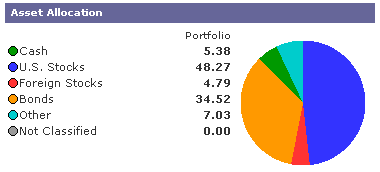
The target allocation I’m trying to maintain is anywhere from a 60/40 mix of stocks/bonds to a 70/30 mix.
The first thing everyone will notice is the relatively high allocation in bonds. Why on earth would anyone my age have nearly 35% of their portfolio in bonds? Well looks can be deceiving. Take a look at the breakdown of the types of bonds in the portfolio:
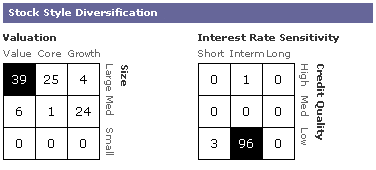
From this you can see that virtually all of the bond holdings (99%) are in low quality bonds. So, these aren’t your conservative bonds that your grandparents hold that churn out 4%. These are bonds in Ford, GM, Cablevision and other “junk” type companies that have comparatively high yields. So while a 60/40 portfolio may seem relatively low-risk, this may not necessarily be the case. The risk is just shifted from market risk from equities to credit risk in bonds.
From that same picture, you can see that the equities are weighted towards large-cap value companies which is quite typical of a portfolio today.
The next thing to consider is the actual type of stocks within this broad mix, relative to the S&P 500:
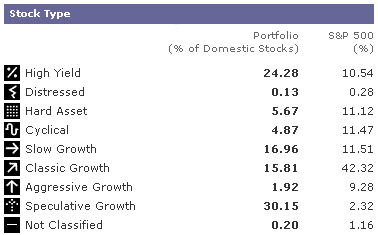
As you can see, my equity holdings do not correlate with the S&P at all, but that is to be expected because I only have a small amount invested in an index. Again, I’m quite heavy in high yield stocks and speculative growth while significantly underweight in classic growth and cyclical companies. In addition to the stock type, it is a good idea to look at what sectors the stocks are in:
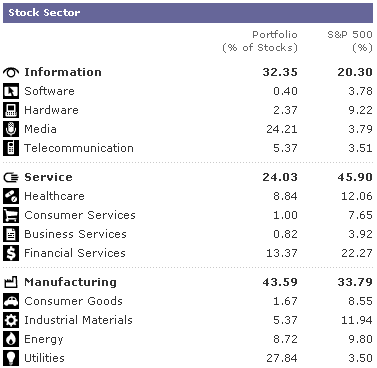
It is no surprise that there is very little in common between these stocks and the S&P. I have a significant portion of my holdings in media and utility companies. No real significance behind it other than the fact that since I’m not relying on one or two index funds, the stock types won’t match very closely.
Finally, let’s move to international holdings. This is where I do need some improvement:
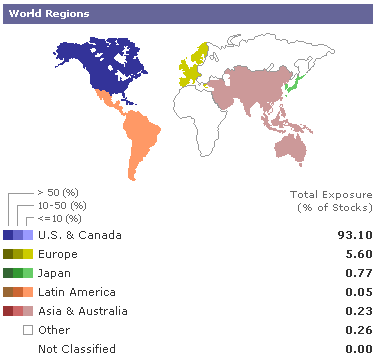
Again, if you look at the overall asset allocation, you’ll see that I only have about 5% in foreign stocks. And of my foreign stocks, I’m primarily in Europe with very little exposure to Asia. My goal is to slowly increase my international holdings to closer to 15%-18% of my overall portfolio and to focus more on Asian companies.
The real reason I have so little in foreign stocks is that when I switched jobs, I lost a decent international fund and the new employer only had one international fund to pick from and it wasn’t the best. So I cut my holdings way back until I could find a suitable alternative in one of my other accounts. Since no part of my portfolio is screaming to be sold, I am just moving back into international positions slowly, with a few iShare ETFs.
How the Portfolio Has Performed
Just looking at the overall allocation numbers, you would probably expect this to underperform the broad markets. Well just to give you an idea of what it has done, it has beaten the S&P in previous years while on the year this portfolio was created, its returns were virtually identical to that of the index.
I have held this general allocation for more than a handful of years and I’ve been continuing to directly compare it against its benchmarks each year. But given the level of risk and volatility of this portfolio versus the returns, I’ve been happy with the results.
Of course this is a constantly changing process but I plan on keeping the core asset allocation in check for at least the next five to ten years. The only thing that will change are the holdings inside the rough 60/40 or 70/30 mix. The real hedge for downside protection will be migrating from junk bonds to higher quality bonds in the event the market looks to be headed down for a long period of time.
Sun’s Sophisticated Investment Portfolio
Behind The Sun’s Financial Diary is a successful investor and married father in his early 40s who moved to the United States from China. One thing that’s inspiring about Sun is that he achieved his healthy net worth in less than 7 years through prudent saving and investing practices.
Sun has held mutual funds and ETFs in the following allocation:
|
Sun’s portfolio is fairly sophisticated and tries to control risk while seeking to maximize reward. Here are a few things I’ve noted with his investment methods:
- He owns a mix of U.S. and foreign individual stocks along with mutual funds and ETFs.
- He began investing in gold when it was still around $300 an ounce! This was back in 2002.
- Sun recognizes that mid to small cap funds are a good investment because historically, smaller cap equities have outpaced larger company stocks.
- He favors international funds and has had a preference for China funds.
- He has purchased I-Bonds regularly for his retirement account.
Investing For The Future
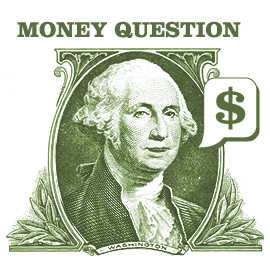
I hope you’ve enjoyed the presentations I’ve put together. The sample investment portfolio allocations have granted me some perspective on what real, financially inclined people are doing and how they’re planning for their future. As mentioned, things change over time and investments are made based on circumstances (economic and personal); thus, what works for others may not work for you a 100%. You’ll need to work out your own portfolio based on your specific needs and goals. For instance, my own portfolio goes through adjustments every year, as I tweak it based on a few personal philosophies:
- I maintain an allocation that I stick to based on my age and risk profile. I tend to be moderately conservative (this is a shift from being moderately aggressive over the past decade).
- I make tactical allocation moves based on my personal analysis and views of the economic “big picture”.
- I try to keep things very simple and mostly subscribe to passive investing approaches.
That wraps it up for now. I’m glad to have learned a good deal from the analysis and discussions that investors have shared on this topic.
So how are you investing for your future?
Created May 17, 2007. Updated February 21, 2012. Copyright © 2012 The Digerati Life. All Rights Reserved.

{ 9 comments… read them below or add one }
Looking at Generation X Finance’s portfolio, 93% of it is US based. I would have spread this portfolio a bit across Europe and Asia. Europe – as a long term investment & Asia short to medium term.
I stumbled on this blog and would definitely drop by from time to time — great job guys!!
Editor: With the advent of the European debt crisis, I wonder if people are thinking twice about Europe’s prospects?
Great post. Getting financial advice is one thing, but I think it says a lot more to see where people are actually putting their money.
I went to all cash about 2 months ago, and am currently waiting till the time is right to get back in. Had I not gone to all cash, well I’d rather not think about that.
Jane
I think you all need to give up any idea of making money in today’s world unless you consider making it with gold and silver. There is a revolution coming and it will be here before you know it.
Chuck Madere
GREAT post!
I’m a frustrated investor myself for many years, and I seem to not really ever have a handle for the right portfolio diversification. Regarding the Gen X Portfolio — the information is fantastic as you broke things down in a digestible manner. I thought that your focus on international stocks was quite intriguing as well:
“Again by looking at the overall asset allocation I only have about 5% in foreign stocks. And of my foreign stocks I’m primarily in Europe with very little exposure to Asia. My goal is to slowly increase my international holdings to closer to 15-18% of my overall portfolio and to focus more on Asian companies.”
I’ve been fairly interested in this area myself recently. Especially after last year, the emerging markets have done so incredibly well. Even after they have waned slightly, I keep looking for international opportunities for exposure. One of the new sites I found was fantastic for researching high yield stocks in emerging markets. They seem to have pretty good coverage on international markets – so something to look into if you are interested.
Thanks again for the article!
Oh!
P.s. – What do you think of the large financial advising institutions? I’ve used them off and on for advice on portfolio diversification to mixed success. Thanks.
I have a question. A friend of mine presented the following scenario as to his investment returns. It doesn’t make sense to me. Am I wrong? This is what he said:
My stocks were up 28% last year, but my 401(k) went down 30%. My stocks were up between 10-60% per year for the 5 years previous. My company’s stock more about tripled….twice, and when my 401k got to be too much of 1 stock (single stock fund in this case), I pulled out. It’s heavily tanked recently with pretty much everyone else in the country. I’m still trying to find the bottom to jump back in. Plus, I invested in energy (oil) up to last spring (should have waited until summer) and have done international heavily for the past 5 years (net importing isn’t favorable for a country’s currency, so international stocks do well even if they go down due to currency fluctuations). The past few years, I’ve expected something like this pullback in the market (though admittedly not nearly to this degree).
My 401k is a subset of my stocks. It went down 30% last year. Second, when I pulled out of my company stock (though not completely) in the 401k, a good chunk of that went to cash. Some of it went into other investments (bond funds, international, etc), so those dropped as has the entire market (including my company stock, which went down more than the market). So it has dropped significantly.
To Jonathan’s quote, I would avoid the large institutions that have a bad name right now, but these shall remain nameless in this post. It is pretty easy to avoid almost 95% of them based on news from the tech bubble or current crisis. No-load fund companies seem the best, rather than hiring an advisor, but you need to create your own strategy or find someone else’s. My website focuses on T. Rowe Price Funds and can be found here and my advice is to find the independent little guy and judge his knowledge. Since he needs the revenue he’ll be willing to show you a more in depth look than you’ll get with the other firms. Disclaimer, my company is not an RIA, so look elsewhere.
Interesting post.
I would say less success comes from proper “portfolio” diversification as much as being contrarian and investing in asset classes that go beyond stocks and bonds into more asset-based classes of investments.